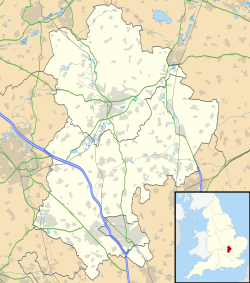Bushmead Priory
| Monastery information | |
|---|---|
| Full name | The Priory Church of Saint Mary, Bushmead |
| Other names | Bissemede Priory |
| Order | Augustinians |
| Established | 1185/1195 |
| Dedicated to | Saint Mary |
| Site | |
| Location | Bushmead, Bedfordshire, England |
| Coordinates | 52°14′01″N 0°22′03″W / 52.233611°N 0.3675°WCoordinates: 52°14′01″N 0°22′03″W / 52.233611°N 0.3675°W |
| Visible remains | refectory and kitchen |
| Public access | yes |
The Priory Church of Saint Mary, Bushmead, commonly called Bushmead Priory, was a monastic foundation for Augustinian Canons, located at Bushmead (a Hamlet in Staploe parish) in the County of Bedfordshire in England. It is a Grade I listed building.
The site and remains of the 700-year-old priory stand today neighbouring a light industrial estate, and disused airfield, and lies between the villages of Colmworth and Little Staughton. Nothing survives of the priory church, and all but the refectory and kitchen of the claustral buildings have disappeared.
Never a large house, the community appears to have consisted of the prior and up to four canons.
The priory was founded around 1195 by William, Chaplain of Colmworth.Hugh de Beauchamp of Eaton Socon endowed the priory with 28 acres (113,000 m²), the priory also held land around Coppingford chapel; during these early years it also held a considerable number of Selions, given to them by local people as gifts of faith. Around 1206 King John permitted the monks to enclose and clear part of the nearby Perry woods.
After William's death in 1215, Joseph, Chaplain of Coppingford, became head of the fraternity. Under his guidance the house became an Augustinian priory. The Augustinians, were then a comparatively new order, which ordained priests, but lived in community similar in style to monks.
Throughout the following years the priory prospered through gifts and grants. The monks wrote documents illustrating their daily lives, these became books of charters, called Cartularies. Unfortunately through the centuries very few of these charters have survived.
...
Wikipedia

